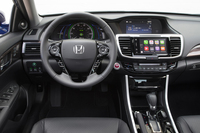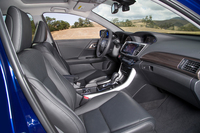2017 Honda Accord Hybrid Touring Review by Carey Russ +VIDEO
Performance, economy, and a great driving experience
DRIVING DOWN THE ROAD WITH CAREY RUSS
• SEE ALSO: Honda Research and Buyers Guide
 |
Honda's ninth-generation Accord got its first mid-product cycle freshening for 2016, with both gasoline-powered sedan and coupe models receiving tweaks to styling and suspension for a revitalized look and improved driving experience. Interestingly, there was no 2016 Accord Hybrid or Plug-In Hybrid.
Which was interesting. Gasoline prices have been low, and hybrids do cost more than their purely internal combustion equivalents. The 2014-15 Accord Hybrid introduced some novel powertrain technology in its “Intelligent Multi-Mode Drive”, hereafter referred to as i-MMD. Honda’s original Integrated Motor Assist (IMA) hybrid system used its electric motor to assist the gasoline engine. Think “electric supercharger” for its effect. Late production IMA systems did actually run in pure electric mode under some conditions, but Honda didn’t make a big deal about that. Which may have cost them points with electric vehicle (EV) fanatics.
In the i-MMA system, power to the drive wheels — front in the Accord — is primarily electric. Most of the time, the gasoline engine -- a 2.0-liter Atkinson-cycle four-cylinder -- powers a generator, which provides electricity to both charge the lithium-ion battery pack and run the traction motor, which powers the wheels. Regenerative braking provides further battery pack charging. Under a light load, as in steady-speed cruising on level ground on surface streets or the highway, the engine shuts off and is disconnected from the drivetrain, and the car operated in EV (electric vehicle) mode. At higher speeds or going up hills at speed, the generator motor and traction motor are deactivated and motive power comes solely from the gasoline engine. Changes between modes are nearly imperceptible, and best noted by the information displays on the instrument panel.
It was quite a sophisticated system to abandon. And it has not been abandoned, it has been improved for the 2017 Accord Hybrid. Its second-generation i-MMA system is lighter in weight, with many components decreased in size and mass, all the better for efficiency. It’s also more powerful, with maximum system horsepower rising from 196 to 212. Both the gasoline engine and electric traction motor produce more horsepower and torque. The lithium-ion battery pack is smaller and lighter, for a minimal impact on trunk capacity. Consumer electronic technology that didn’t exist in 2014, like Apple CarPlay and Android Auto, is standard. EPA fuel economy ratings are up, although the way those ratings are calculated has changed so direct comparison won’t be telling.
My week with a top-of-the-line 2017 Accord Hybrid Touring was a typical winter week where I live. Meaning weather from sunny days in the 60s to strong wind and pouring rain, with daytime temperatures barely into the 50s. (Yeah, those of you where winter is more like Pleistocene v2.0 are laughing) The Accord Hybrid was always quick when needed, and remarkably smooth and quiet except for engine noise under maximum-throttle acceleration, as on short highway onramps. With its leather interior and comprehensive suite of luxury-class convenience and safety equipment, it is the luxury flagship of the Honda lineup. Fuel economy, however, was a bit disappointing — but, especially in a hybrid, fuel economy is dependent on driving style. 0-60 in just over seven seconds does not 50 mpg make — but it does keep you safe merging into fast traffic. Also, the load on the electrical system from accessories like lights, wipers, heat, and seat heaters does make a difference. Where I saw 40-plus mpg on a sunny dry day, I saw eight to ten mpg less in the rain. If my week’s average of 34 mpg wasn’t much higher than the 32 of a 2016 four-cylinder Accord tested last year, city stints of 40 to 55 mpg were considerably better. I got a 38 mpg average in the 2014 Accord Hybrid. YMMV, as the saying goes. The Honda Accord Hybrid in Touring form is a luxury car in all but its nameplate.
APPEARANCE: Differences between a Hybrid and a regular Accord are subtle but visible. Badging on the fenders ahead of the front doors and at the rear and blue-accented chrome in the grille and around the LED headlights are the hints. Other than that, it's a current Accord, a conservatively handsome sedan that doesn't attempt to be anything but an honest sedan. Which is a rarity today, so congratulations to Honda on that.
 |
COMFORT: Inside as well, the Hybrid is little different from a regular Accord Touring. Which means leather seating, power-adjustable and heated in front, Build quality and fit and finish as as expected from Honda, top notch. The interior design is conservative, with no attempts to emulate anything other than a functional automobile. The quickest way to tell that this is not a "real" luxury car is that interior trim materials are unapologetically plastic (but high-quality plastic), not aluminum and wood. So? It doesn’t have a luxury car price, either. Seat comfort and support are very good, instruments are easily visible with no glare difficulties, and the controls are easy to use. The Hybrid's instrument display does differ from that of the regular Accord in that there is no tachometer, as the engine is not under direct driver control. The speedometer encompasses a central information display with an eco-driving coach and power-flow monitor most useful, and is flanked by a power generation/consumption graph on the left and battery and fuel level gauges on the right. The standard "Intelligent Multi-Information Display" (i-MID) screen at the top of the center stack shows audio and economy information plus views from the backup and LaneWatch cameras. Audio choices here are AM, FM, and SiriusXM radio, CD, remote player via a USB port, or various streaming audio apps now including Apple CarPlay® and Android Auto (with a compatible phone and service). There are useful storage spaces around the cabin, including pockets with bottle holders in all four doors. The glovebox locks. Rear passengers get a contoured bench seat with plenty of elbow room and both floor heat and end-of-console HVAC vents. The central tunnel is low enough that the center position is useful, at least for a short time. There is a central armrest but the battery and controller position behind the rear seat means no folding seatback and reduced trunk space, although not as reduced as before thanks to the more compact hybrid battery and control electronics. It also means no spare tire, just a seal and inflation kit.
 |
SAFETY: The Honda Accord has received high ratings in both government and private testing. Passive safety is addressed by the "Advanced Compatibility Engineering™" unibody structure designed and constructed to control crash energy and protect passengers. The usual front, front-seat side, and full-length side-curtain airbags and side-impact door beams offer further protection. Vehicle Stability Assist™ and traction control enhance driver control, as do antilock disc brakes with electronic brake-force distribution (EBD) and Brake Assist (BA). Forward Collision Warning, Lane Departure Warning, Collision Mitigation Braking, Lane Keep Assist, Road Departure Mitigation, and Adaptive Cruise Control systems are standard in the Touring as the Honda Sensing™ package. The LaneWatch™ passenger-side blind-spot system is one of the most useful new safety features around and a Honda exclusive.
RIDE AND HANDLING: If you think hybrids are boring and no fun to drive, you need to drive this car. While it uses the same fully-independent MacPherson strut front, multilink rear suspension design as regular Accords, the Hybrid gets amplitude reactive shock dampers, with twin internal damping systems to correctly deal with both smooth and bumpy, potholed road surfaces. Surprisingly, it's all mechanical/hydraulic, not electronic. Larger anti-roll bard mean flat cornering, and this is a car that deals with twisting, hilly roads with pleasure. The electrically-assisted steering requires a moderate touch, and is not too numb. Brake performance is excellent, with the four-wheel discs supplemented by regenerative braking. The brake system is electronically-controlled, and the "B" shift position activates a higher level of regenerative braking when descending long grades. Recharge that battery as you slow! And save brake pads, too.
PERFORMANCE: The i-MMD system combines a 2.0-liter, four-cylinder Atkinson cycle gasoline engine (143 hp at 6200 rpm and 12 lb-ft of torque art 4000 rpm, increases of 2 hp and 7 lb-ft) with a permanent-magnet synchronous AC traction motor (232 lb-ft between 0 and 2000 rpm, 181 hp between 5000 and 6000 rpm, 6 more lb-ft and 15 additional horsepower). Maximum combined horsepower is 212, up a noticeable 18, torque not specified. Note that the motor is more powerful than the engine. As explained, the engine usually drives a generator, which then powers the traction motor. An electric motor makes maximum torque as soon as it spins -- so if you miss the low-end torque of the muscle car era, EVs will not necessarily be bad. At speeds where the motor's torque starts to fade, the engine comes into its own, and the motor is then de-clutched while the engine is clutched into the system. Under low-load, steady-speed cruising or gentle acceleration, the engine is turned off and the battery supplies power to the traction motor. There is also the motor-generator, primarily driven by the engine to charge the battery pack, and as the starter motor for the engine. Both motor/generators are smaller and lighter than in the previous generation, and more powerful. Everything is computer controlled, and there is no transmission as such. What Honda calls the "e-CVT" is not a pulley-type continuously-variable transmission but its term for a system of clutches that route torque from the different sources to the (front) drive wheels and the electronic controls that make it work.
And it works very well. Acceleration to highway speeds is much more than adequate, and very smooth. Acceleration at highway speeds is no problem, either -- it does not "run out of breath" at 70 mph or so (which is life in the slow lane in these parts). There is now a Sport mode, which adds more battery assist to the traction motor and quickens throttle response. Fuel economy varies with driving style and traffic conditions, but at worst is still better than the four-cylinder Accord and far better than the V6. At best, it's exemplary.
CONCLUSIONS: Performance as well as economy from a hybrid? And with an engaging driving experience? Yes to all with the 2017 Honda Accord Hybrid.
SPECIFICATIONS
2017 Honda Accord Hybrid Touring
Base Price $ 35,955
Price As Tested $ 36,790
Engine Type DOHC 16-valve aluminum alloy 4-cylinder Atkinson-cycle with i-VTEC variable cam phasing and lift
Engine Size 2.0 liters / 122 cu. in.
Horsepower 143 @ 6200 rpm
Torque (lb-ft) 129 @ 4000 rpm
Electric Traction Motor AC Synchronous permanent magnet
Horsepower 181 @ 5000 - 6000 rpm
Torque (lb-ft) 232 @ 0 - 2000
Total System Horsepower 212 @ 6200 rpm
Transmission "e-CVT" multiple drive modes
Wheelbase / Length 109.3 in. / 194.1 in.
Curb Weight 3536 lbs.
Pounds Per Horsepower 16.7
Fuel Capacity 15.8 gal.
Fuel Requirement 87 octane unleaded regular gasoline
Tires P225/50R17 94V Michelin Energy A/S
Brakes, front/rear vented disc / solid disc, ABS
Suspension, front/rear independent MacPherson strut / independent multilink Drivetrain transverse front engine and motor, front-wheel drive
PERFORMANCE
EPA Fuel Economy - miles per gallon city / highway / observed 49 / 47 / 34
0 to 60 mph 7.2 sec
OPTIONS AND CHARGES
Destination Charge $ 835



